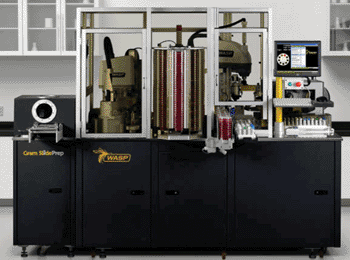Automated Gram Smears Equated to Manual Preparations
By LabMedica International staff writers
Posted on 23 Jul 2013
A comparison has been made of Gram smear preparations for identifying bacteria by both a manual method and a Walk Away Specimen Processor (WASP). Posted on 23 Jul 2013
It is recommended that 30 µL of ESwab sample is the optimal volume for the preparation of manual or automated Gram smears with representation of all elements important for a clinical outcome.

Image: The Walk-Away Specimen Processor (Photo courtesy of Copan Italy).
Microbiologists at the Algemeen Medisch Laboratorium (AML; Antwerp, Belgium) analyzed 300 genital samples submitted to the laboratory for routine investigation. All samples were collected with eSwab (Copan Italia; Brescia, Italy) and two smears were prepared from all collected samples.
One smear was prepared manually, by directly streaking the flocked swab from the eSwab sample collection onto a glass slide and dried at room temperature. The second smear was prepared automatically on the Copan WASP with the extended Gram SlidePrep Module. A protocol for smear preparation had been created on the WASP using the 10-µL loop. Both manual and automated prepared smears were fixed with 95% methanol for one minute, stained using the Elitech Gram reagents and methodology (Wescor Inc.; South Logan, UT, USA) and examined under a light microscope with 10 × 100 magnification.
Smears were semiquantitatively evaluated for the presence of the following elements: Lactobacillus, Gardnerella vaginalis, clue-cells, Mobiluncus species, leucocytes, and epithelial cells. The number of Lactobacillus, G. vaginalis, clue-cells, and Mobiluncus present on each smear was also evaluated using the Nugent score system to diagnose bacterial vaginosis. Manual prepared smears had 78% Lactobacillus, 16.6% G. vaginalis, 4.6% Mobiluncus species, and 13.6% clue-cells, while the WASP prepared smear detected 72%, 16%, 5%, and 15% respectively with 10 µL of eSwab sample.
The authors concluded that Gram smears, prepared with 10 µL of eSwab sample on the WASP, had similar number of microorganisms compared to the manual Gram smear in the presence of leucocytes and epithelial cells. The use of the 10-µL loop instead of the 30 µL on the WASP improved the workflow by avoiding changing the loop while processing the same sample. The study was presented at the American Society of Microbiology annual meeting held May18-21, 2013, in Denver (CO, USA).
Related Links:
Algemeen Medisch Laboratorium
Copan Italia
Wescor Inc.













